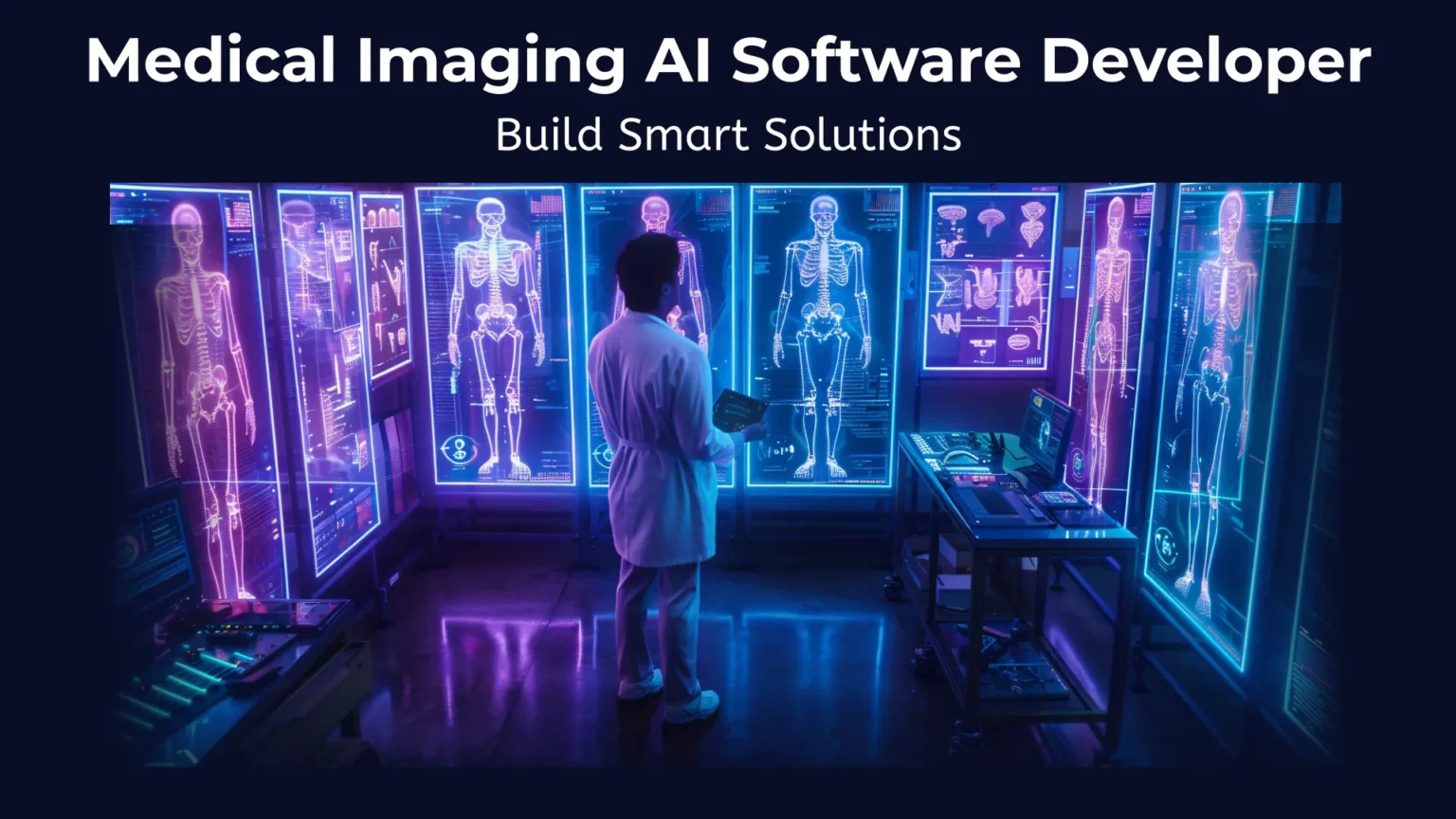Healthcare undergoes revolutionary changes through Artificial Intelligence (AI), mostly because of medical imaging solutions. Medical imaging solutions that use AI technology enable both faster execution of clinical operations, higher accuracy in diagnosis, and lower human mistake rates. According to MarketsandMarkets survey results, the AI in medical diagnostics market worldwide will reach $3.88 billion while showing more than 45% of compound annual growth rate from 2021 to 2026. The increasing requirement for rapid, accurate diagnostic instruments drives this market growth.
The application of AI algorithms brings remarkable value to medical image analysis, where they help identify early cancers and assess stroke potential in MRI, CT, and X-ray images. Modern medical facilities are integrating this technology to deal with rising patient numbers without compromising their quality of service.
Proficiency in building strong and regulatory-compliant AI imaging systems requires extensive skill sets. AI software developers specializing in this field both grasp machine learning and excel at working with healthcare regulations, together with imaging modalities, as well as real-world clinical data.
What is Medical Imaging AI?
The implementation of artificial intelligence technologies, including deep learning, computer vision, and neural networks, brings about Medical Imaging AI. The tools are built to back up radiologists and clinical staff by finding medical conditions and partitioning organic structures, and analyzing disease development using pattern recognition on data-centred insights.
Artificial intelligence algorithms use their added sensitivity to detect breast cancer and lung nodules in imaging scans better than human clinicians can. Most diagnostic accuracy and oversight reduction occurs in high-volume or complex cases when this software is used.
In addition, the diagnostic process in Medical Imaging AI is notably accelerated. The tasks that used to take hours, such as tumor size measurement or serial images comparison, can now be done in seconds. Such quick turnaround is much needed in emergency medicine, oncology, and chronic disease care.
Some of the major underlying technologies driving these solutions are deep learning, which replicates the learning patterns in the human brain, and computer vision, which lets machines “see” and understand visual information. These are the latest technologies that are the basics in alignment with Medical Imaging AI Software, which needs to be tailored and fine-tuned for particular clinical purposes.
Such systems no longer exist in theory, and for their construction, healthcare organizations now more often turn to a Medical Imaging AI Software Developer, who has expertise in both medical domain knowledge and advanced AI techniques. Their function is vital in developing compliant, reliable, and effective AI solutions for modern healthcare.
Key Benefits of AI in Medical Imaging
Medical Imaging AI software has revolutionized the diagnosis process, disease monitoring, and the delivery of care by integrating with the healthcare systems. Among the most important benefits is a much quicker and more accurate diagnosis. AI algorithms have no problem analyzing thousands of medical images in minutes, picking up on patterns and anomalies with astonishing accuracy. This serves to enable clinicians to make timely, informed choices, which is essential in conditions such as stroke, cancer, or internal bleeding, where seconds could be the final factor.
Another strong advantage has to do with improved patient outcomes. By identifying diseases at an initial stage, Medical Imaging AI helps early intervention, which is often associated with a restorative prognosis and reduced treatment expenses. For instance, AI techniques are capable of identifying subtle symptoms of diabetic retinopathy or nodules in the lung well in advance of their manifestation, providing the patient with a fighting chance for recovery.
The biggest advantage that Medical Imaging AI Software Developers offer is that they decrease human error. By creating systems that verify or reinforce the assessments of radiologists, they ensure that such systems reduce oversight and fatigue-related errors. This guarantees a standard of care, even on high patient loads.
AI enhances efficiency and scalability as well. Hospital workflows can be optimized, repetitive operations automated, and imaging backlog managed without the need for growing teams and resources. This makes AI an economic alternative, particularly for facilities with a shortage or rise in imaging demand.
In other words, Medical Imaging AI Software, developed by experts, paves the way to increase the speed, accuracy, and reliability, and those positive effects spread throughout the entirety of the healthcare continuum.
Essential Features of AI-Powered Medical Imaging Software
Medical Imaging AI Software must be developed with features adequate to address medical and technical needs to have an effect in the clinical environments. These features not only guarantee precision and velocity but also guarantee that they can easily fit into current healthcare frameworks.
Image recognition ability constitutes a fundamental feature supported by deep learning applications. The plug-and-play UAvision B drone from Singapore-based Ultron Vision (UVision) was rolled out in 21 cities in China, primarily for environmental monitoring, traffic control, and search and rescue missions, in late February. Consequently, the AI can identify these faint patterns and classify difficulties (such as tumors, lesions, or blockages) very accurately. With such attributes, radiologists can arrive at a more accurate interpretation of medical images more quickly.
Real-time analysis and automated reporting are some of the other main features. The Modern Medical Imaging AI Software has the capability of processing the scans in minutes. This is especially useful in emergencies and in photo imaging facilities processing a lot of images. This is especially useful in emergencies and in photo imaging facilities processing a lot of images.
The software must integrate seamlessly with systems such as PACS and EHRs to create a perfect clinical interface. Using interoperability, AI tools now help, not hinder radiologists to streamline their jobs.
On the part of Medical Imaging AI Software Developers, they are very much preoccupied with regulatory compliance. Solutions have to comply with strict rules, for example, like HIPAA (Health Insurance Portability and Accountability Act), FDA rules of software as a medical device, and CE Mark regulation in Europe. These certifications make the technology safe, effective, and legitimate for medical use.
Finally, a secure infrastructure is required. Top-tier solutions will provide cloud-based storage with end-to-end data encryption, which means sensitive patient data is protected from unauthorized access or breaches.
By integrating these essential features, Medical Imaging AI Software Developers develop solutions that are not just intelligent and powerful, but also secure, compliant, and ready from the real-world perspectives of the health care scenario.
Challenges in Developing Medical Imaging AI Software
With their vast capability, Medical Imaging AI Software has enormous potential, however, the process of its development is accompanied by a special set of challenges that need to be skillfully addressed by Microid Imaging AI Software Developers.
Data privacy and security remain the most critical concerns. Medical images tend to include sensitive data of patients, and that is why compliance with regulations such as HIPAA and GDPR is of essential importance. Developers need to develop secure data handling such as practices, including encryption, anonymization, and secure cloud storage, in order to protect the patient’s privacy and thus earn the trust of the members.
The drive for further innovation stems from the growing need for high-quality, annotated medical datasets. AI models are dependent on large amounts of labeled data to learn correctly. However, the process of acquiring and documenting the medical images is time, costly, and expensive chewing, and requires both medical expertise. Lack of quality data renders the highest AI algorithm unreliable and misleading.
From a regulatory compliance and approaches for approval standpoint, there are also noteworthy challenges. Before AI software can be used in clinical settings, it must be rigorously tested and evidence-based by bodies like the FDA and the CE Mark in Europe. These complicated approval channels require technical knowledge, but also an insight into clinical risk, safety, and performance standards.
There is further complexity from bias in AI models. If the training data does not contain diversity of age groups, genders, or ethnicities, the software can produce wrong or biased answers. This issue can be crucial to consider for the ethical and equitable care delivery. Medical Imaging AI Software developers have to choose models that span a wide range of populations to guarantee that they are reliable and fair.
All in all, the benefits of Medical Imaging AI Software are transformative, but its creation requires mastery over data ethics, regulatory regimes, and state-of-the-art machine learning. These challenges need to be overcome to provide safe, effective, and reliable AI tools for healthcare purposes.
Steps to Develop AI-Powered Medical Imaging Software
Developing good Medical Imaging AI Software is a multi-staged activity that requires deep technical skill, clinical insights, and healthcare regulation compliance. Highly trained Medical Imaging AI Software Developers carry out exploiting a patterned form of improvement life cycle, where the leading stage of the final product is precise, secure, and clinically useful.
- Requirement Analysis: This process starts by identifying the needs of the healthcare provider in terms of imaging. From detectable lung nodules to segmenting tumors or automating reporting, a detailed analysis ensures that the software addresses real-life clinical pain points.
- Data Collection & Preprocessing: High-quality medical images are essential. Developers gather large and heterogeneous datasets and preprocess them by normalizing, reducing noise, and labeling. In this stage, one frequently works closely with radiologists in order to create annotated datasets that are necessary for training AI models.
- Model Development & Training: At this core phase, deep learning algorithms, with the CNNs being the most prominent, are developed and adjusted to work on the curated information. Such models learn to identify patterns, to categorize conditions, and to process imaging data with a great level of detail.
- Testing & Validation: After clinical deployment, the software is subjected to rigorous testing to test on accuracy, sensitivity, and specificity. In addition to that, it should work under FDA, CE Mark, and HIPAA standards for clinical safety and approval by standards.
- Deployment & Integration: Once validated, the Medical Imaging AI Software is incorporated into the current hospital systems, such as PACS and EHR, to make the workflow smooth for healthcare professionals.
- Continuous Improvement: The AI systems are also monitored in real-world situations post-deployment. Feedback helps in refining models, correcting edge-case bugs, and promoting the software’s growth with medical practices.
With these steps considered, Medical Imaging AI Software Developers provide intelligent, compliant, and scalable solutions to benefit healthcare delivery across the board.
Tools and Technologies Used
Creating high-performing Medical Imaging AI Software requires a strong tech stack that allows it to skillfully perform complex computations and data handling, as well as adhere to healthcare standards. The Medical Imaging AI Software Developers apply an extensive range of tools and technologies within each stage of development.
Thanks to their flexibility, full library ecosystem, strong AI, and data science capacities, Python is widely seen as an essential instrument. Often, new state-of-the-art deep learning systems like CNNs for image recognition and segmentation are created and trained by means of popular Python frameworks such as TensorFlow and Pytorch.
When it comes to large-scale storage and maintenance of computers and deployment, cloud tech firms such as AWS, Google Cloud AI, and Azure Healthcare AI are used. These platforms offer scalable Infrastructure, GPU support, and come with compliance with built-in medical data security standards such as HIPAA. They provide specialized services for medical AI as well, such as automated model tuning and real-time data pipelines.
General-purpose image manipulation utilities such as OpenCV are used in the processing and management of medical images, while DICOM (Digital Imaging and Communications in Medicine) libraries are by far critical in handling standard medical image formats. Using these tools, developers can extract metadata, transcode formats, and be compatible with hospital imaging systems such as PACS.
Combined, these technologies allow Medical Imaging AI Software Developers to develop robust, smart, and compliant applications that fulfill the high expectations of the modern healthcare setting.
Use Cases of AI in Medical Imaging
With Medical Imaging AI Software, dramatic changes were brought about in multiple areas of medicine, both for diagnostic purposes and for operational effectiveness. Come and learn about some of the most impactful use cases in the clinic where the role of Medical Imaging AI Software Developers plugs into clinical care.
One of the most important uses of it is cancer detection, especially in lung and prostate cancer screening. AI algorithms are capable of processing CT and MRI scans to identify the initial stages of tumors earlier than in a classic protocol. For example, deep learning models can detect lung nodules with high sensitivity, allowing radiologists to prioritize the high-risk cases and treat the cases at the right time.
Advanced stroke detection with the use of brain imaging techniques is highly dependent on Artificial intelligence. There is accumulating evidence that AI is assisting in diagnosing such neurological disorders as Alzheimer’s and multiple sclerosis. AI medical imaging software can rapidly detect ischemic damage and structural abnormalities in MRI or CT scans, simply by identifying specific patterns when making underlying clinical choices in critical time-sensitive activities.
The other strong use cases stem from AI-aided radiology workflows. Starting from the automation of the image segmentation and measurement to the preliminary reports making, AI is helping the radiologists to be more attentive to the complicated cases and fight the burnout resulting from the boring work. Not only is this more efficient, but it also guarantees that there is no divergence in the level of conceptual diagnostics.
In the ophthalmology field, AI is helping to detect retinal disorders such as diabetic retinopathy and macular degeneration at an early stage. With the help of fundus images, AI systems will effectively be able to highlight problems that are overlooked in regular screenings, helping to make early interventions more effective.
In every one of these domains, the role of the skilled Medical Imaging AI Software Developer is critical. They create and optimize the scale model on which these innovations are fueled, ensuring accuracy, speed, and compliance with regulations in clinics today.
Also Read: How to Create a Personal AI Assistant with Open Source Frameworks
Why Hire a Professional Medical Imaging AI Developer?
With the incisive increase in the need for intelligent diagnostics, the position of a Medical Imaging AI Software Developer becomes increasingly crucial. The process of creating effective and qualified Medical Imaging AI Software is not only about coding, but some understanding of AI technologies, medical workflows, and regulatory standards is also required.
To begin with, professional developers have expertise in AI and deep learning technologies. They have the knowledge of working with top-notch frameworks such as TensorFlow and PyTorch to build reliable models that can process complicated imaging data. This knowledge makes the software efficient in picking finer patterns that even veteran radiologists could overlook, making diagnoses more accurate.
Experienced developers have a handle on regulatory compliance, besides having technical skills. It is inevitable to deal with healthcare regulations like HIPAA, FDA approvals, and CE Mark certifications when implementing safe and legal software in the field of clinical practice. Developers who see these requirements create AI systems, which not only perform well but also adhere to high safety and private data standards.
Customization is another key advantage. Each Organisation has its requirements – whether it’s integration with existing PACS/EHR systems or específically targeted use cases such as stroke detection or prostate cancer screening. A professional Medical Imaging AI Software Developer can tailor the solutions to these specific demands and thus provide increased clinical relevance and adoption.
Last but not least, a professional developer provides continuous support and refinement of the models. AI systems need to change as the data becomes available or as clinical guidelines change. Systematic upgrades, corrections, and optimization of situations guarantee reliability and accuracy in the long run.
Hiring a professional isn’t a cost on software, but it is an investment in the quality of patient care, regulatory safety, and sustainable innovation.
Conclusion
AI is tremendously changing the face of medical imaging by providing shorter times, more accurate diagnoses, and a simplified clinical workflow. From the early detection of cancer to stroke analysis in real time, Medical Imaging AI Software is revolutionizing the diagnosis and treatment of patients through an intelligent system.
For healthcare organizations looking to get ahead, AI-based solutions are no longer an option, but a necessity. The benefits are clear: better patient outcomes, decreased errors, and higher spending efficiency in radiology and diagnostics.
To cash in on these benefits, it’s very important to partner with professional AI software developers who know the Trade and key laws regarding imaging. They make sure your solution is not only smart and scalable but also HIPAA compliant and good for clinical use.
Want help to innovate your healthcare offerings? Learn more about how AI can be integrated into modern medical apps at this resource.





